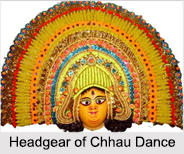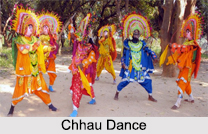 Costumes of Chhau dance have not yet been thoroughly modernised in any way. There has been a gradual evolution as far as the costumes are concerned. Chhau Dance is a popular form of tribal dance in India which is mainly seen in the states of Odisha, West Bengal and Jharkhand. This form of dance is a means to portray stories to the audience, which is why sophisticated masks and headgear related with battle and war are worn throughout the performance.
Costumes of Chhau dance have not yet been thoroughly modernised in any way. There has been a gradual evolution as far as the costumes are concerned. Chhau Dance is a popular form of tribal dance in India which is mainly seen in the states of Odisha, West Bengal and Jharkhand. This form of dance is a means to portray stories to the audience, which is why sophisticated masks and headgear related with battle and war are worn throughout the performance.
Costumes of Chhau Dance
The technique and range of the costume of Chhau dancers mainly depends on the characters being depicted by them. Generally, there are three types of characters - Gods and Goddesses, Demons and Monsters. When depicting Gods and Goddesses, red colour is a major feature of the clothing. The attire for Gods and Goddesses can also consist of a few extra sets of arms along with trademark weapons that a particular God or Goddess was known for wielding.
When depicting the Demons, dancers elaborately dress up and most of them like to have different coloured faces. Apart from this, the costume itself does not differ that much. For monsters and animals suits made to portray an animal or monster along with that suitable masks are worn. Like while portraying a lion, a dancer will put on a lion suit along with a lion mask. This may be accompanied by a weapon such as a sword. The masks necessitated a regular set of costumes which must have undergone change over a period of time. A piece of ordinary trouser made most economically of cloth of different colours for Gods and demons with stripes, each being about six inches apart, is used by the heroes.
 Generally, a God`s trouser would be of deep red or green colour with stripes of the alternate colour and is equally deep. There has been a tendency to imitate the artistes of the "Yatra". In such cases, the dancers put on coloured sarees or women`s cloth as their lower garments. Women characters are rare in Chhau dance. Goddess Kali appears with a very tight black trouser without any stripes, resembling her own skin colour. This is the only instance of a woman`s character putting on men`s costume. Demonesses wear unconventional cloths or even short trousers or half pants made of deep black coloured cloth of the most ordinary quality. Characters of birds and animals are represented by the artists, with the masks of respective animals and with the realistic nature costumes. Jatayu is represented with mask of the bird covering his face and two artificial wings on its two sides. The costumes are made of feathers of birds. Hanuman, Sugriva, the monkey-chief of Kiskindhya and Bali his royal brother appear with tails. In some cases the divine characters possess some additional limbs like hands, heads and so on. Goddess Durga is represented by the ten-handed, Ganesha and Kali are represented by four handed each and Ravana is represented by ten-heads.
Generally, a God`s trouser would be of deep red or green colour with stripes of the alternate colour and is equally deep. There has been a tendency to imitate the artistes of the "Yatra". In such cases, the dancers put on coloured sarees or women`s cloth as their lower garments. Women characters are rare in Chhau dance. Goddess Kali appears with a very tight black trouser without any stripes, resembling her own skin colour. This is the only instance of a woman`s character putting on men`s costume. Demonesses wear unconventional cloths or even short trousers or half pants made of deep black coloured cloth of the most ordinary quality. Characters of birds and animals are represented by the artists, with the masks of respective animals and with the realistic nature costumes. Jatayu is represented with mask of the bird covering his face and two artificial wings on its two sides. The costumes are made of feathers of birds. Hanuman, Sugriva, the monkey-chief of Kiskindhya and Bali his royal brother appear with tails. In some cases the divine characters possess some additional limbs like hands, heads and so on. Goddess Durga is represented by the ten-handed, Ganesha and Kali are represented by four handed each and Ravana is represented by ten-heads.
Chhau of Purulia use the mask in dance, but Odisha does not have the mask instead the performance is done by adding facial expression with body movement and gesture. The chhau masks are made by the artists from the Sutradhar community. The making of a mask goes through various stages. 8-10 layers of soft paper, immersed in diluted glue, are pasted one after another on the mould before the mud mould is dusted with fine ash powder. The facial features are made of clay and a special layer of mud and cloth is applied and then sun-dried. After this, the mould is polished and the second round of sun drying is done before separating the layers of cloth and paper from the mould. After finishing and drilling of holes for the nose and eyes, the mask is coloured and decorated.



















